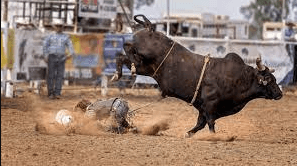What Are The Risks Of Bull Riding?

Bull riding, a popular rodeo sport that requires immense physical and mental strength, poses significant risks to its participants. This article aims to explore the various dangers associated with bull riding in an objective and informative manner. By analyzing potential physical injuries, mental health hazards, and long-term health effects, readers will gain a comprehensive understanding of the risks involved in this exhilarating yet perilous activity.
The first area of concern when it comes to bull riding is the potential for severe physical injuries. Every time a rider mounts a bull weighing over 1,500 pounds, they expose themselves to various dangers such as broken bones, concussions, internal bleeding, or even paralysis. The sheer force and unpredictability of these animals make it extremely challenging for riders to maintain balance and stay on top of the raging bulls. Consequently, falls are frequent during competitions and can result in life-altering injuries that require extensive medical attention and rehabilitation.
Beyond physical harm, bull riding also presents mental health hazards that deserve attention. The constant pressure to perform at high levels coupled with the fear of facing an aggressive animal can lead to significant stress and anxiety among riders. Moreover, the adrenaline rush experienced during each ride may initially be enticing but can have long-lasting psychological effects. Riders often face post-traumatic stress disorder (PTSD) due to past traumatic experiences or repeated exposure to dangerous situations. These mental health challenges should not be overlooked as they can have profound impacts on both personal well-being and overall performance in this demanding sport.
By examining the potential physical injuries, mental health hazards, and long-term health effects associated with bull riding objectively and analytically, this article aims to provide readers with valuable insights into the risks involved in this daring pursuit of freedom. Understanding these risks is crucial for individuals considering participation in bull riding or those interested in gaining knowledge about this intense sport’s inherent dangers.
Potential Physical Injuries
Potential physical injuries associated with bull riding include fractures, concussions, dislocations, lacerations, and contusions. Bull riders face the constant risk of being thrown off or trampled by the unpredictable animals they ride.
Fractures are commonly seen in bull riders due to the immense force exerted on their bodies when they are thrown off a bull. Concussions can occur when riders are violently jolted or hit their heads against the ground or walls of the arena.
Dislocations may result from sudden jerks and twists during a ride, particularly in the shoulder and hip joints. Lacerations can be caused by contact with horns or hooves, and contusions often occur as a result of falls or impacts.
The rehabilitation process for these injuries can be lengthy and challenging, requiring medical intervention, physical therapy, and time to heal properly before returning to sport. To mitigate these risks, safety precautions such as wearing protective gear like helmets and vests are crucial for bull riders to minimize the impact of potential injuries.
It is also essential for organizers to enforce strict rules regarding animal welfare and rider safety measures to ensure a safer environment for participants in this exhilarating yet hazardous sport.
Mental Health Hazards
The mental toll of participating in this physically demanding sport can be likened to navigating treacherous waters without a compass, as bull riders face significant challenges to their psychological well-being.
The high stakes and constant pressure of performing at their best can lead to immense stress and anxiety for bull riders. They are constantly exposed to the risk of injury and even death, which further adds to the already existing pressure.
To shed light on the impact of bull riding on mental health, here are four key aspects that must be considered:
1) Stress management: Bull riders have to develop effective strategies for managing stress in order to cope with the demands of their sport. The intense physical exertion combined with the fear and adrenaline rush during each ride can take a toll on their mental well-being. Finding healthy ways to cope with stress becomes crucial for maintaining overall psychological health.
2) Self-esteem: Success or failure in bull riding can have a profound impact on a rider’s self-esteem. When they conquer a powerful bull, it boosts their confidence and sense of achievement. However, failures or injuries can lead to feelings of inadequacy and self-doubt. The constant evaluation by judges and spectators adds an additional layer of scrutiny that may affect self-perception.
3) Psychological trauma: Bull riding carries inherent risks, including traumatic experiences such as being thrown off or trampled by a bull. These events can result in post-traumatic stress disorder (PTSD) symptoms or other psychological trauma. Riders may experience flashbacks, nightmares, or heightened anxiety related to these traumatic incidents.
4) Emotional resilience: Bull riders need strong emotional resilience to bounce back from setbacks and stay focused despite the challenges they face both inside and outside the arena. Developing emotional coping mechanisms is essential for maintaining mental well-being while participating in this demanding sport.
Participating in bull riding poses not only physical but also significant mental health hazards for riders. Effective stress management techniques and support systems are crucial in helping riders navigate the psychological challenges they encounter.
Understanding and addressing these mental health risks is vital for protecting the well-being of bull riders in a sport where physical strength alone is not enough.
Long-Term Health Effects
Long-term health effects associated with participating in this physically demanding sport include an increased risk for musculoskeletal injuries and chronic pain.
Bull riding, known for its intense physical demands, puts riders at a higher risk of sustaining injuries such as fractures, dislocations, and soft tissue damage.
The repeated trauma to the body can lead to long-lasting cognitive impairment and chronic pain.
Cognitive impairment may result from concussions or head injuries sustained during falls or being thrown off the bull.
Chronic pain can arise from various factors, including repetitive stress on joints and muscles, spinal misalignments, and nerve compression caused by the constant jolting motions experienced while riding bulls.
It is essential for bull riders to understand these potential consequences and take appropriate measures to protect their long-term health.
Frequently Asked Questions
What are the rules and regulations of bull riding competitions?
Bull riding competitions have strict rules and regulations governing the selection process, safety measures, and conduct. These events have a rich history and origin, showcasing famous bull riders who have achieved success and recognition. The exhilarating nature of this sport appeals to those with a subconscious desire for freedom.
How are bulls selected for bull riding events?
The bull selection process involves assessing the physical attributes and temperament of potential bulls. Bull training techniques focus on conditioning them to be aggressive and unpredictable, enhancing the challenge for riders in bull riding events.
What safety measures are in place to protect riders during bull riding?
Safety measures in bull riding include the use of safety equipment such as helmets, vests, and mouthguards. Riders also undergo rigorous training programs to enhance their skills and minimize the risk of injuries.
What is the history and origin of bull riding as a sport?
The history and evolution of bull riding as a sport can be traced back to ancient civilizations, where it held cultural significance. It has since evolved into a popular rodeo event that showcases the bravery and skill of riders.
Are there any famous bull riders who have achieved significant success or recognition in the sport?
Famous bull riders, like Lane Frost and Ty Murray, have achieved remarkable success in the sport. Their dedication, skill, and fearless determination have propelled them to become icons in the world of bull riding.
Conclusion
Bull riding is a dangerous sport that poses several risks to the riders. In terms of physical injuries, bull riders are susceptible to fractures, concussions, and internal organ damage.
Additionally, there are mental health hazards associated with the sport, including anxiety, depression, and post-traumatic stress disorder.
Furthermore, participating in bull riding can lead to long-term health effects such as chronic pain and joint degeneration.
In conclusion, bull riding comes with significant risks that cannot be ignored. The physical injuries sustained during this sport can have lasting consequences on the riders’ well-being.
Moreover, the mental health hazards associated with bull riding can also greatly impact their overall quality of life. Despite these risks, some may argue that bull riding provides an adrenaline rush and a sense of accomplishment for the participants.
While it is true that individuals may find enjoyment in this extreme activity, it is crucial to prioritize safety and consider the potential long-term consequences on both physical and mental health.
Therefore, it is important for participants and organizers alike to take necessary precautions and implement measures to minimize these risks while still allowing individuals to pursue their passion for this challenging sport.




